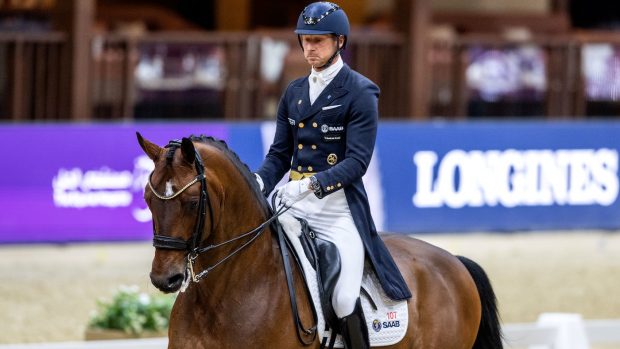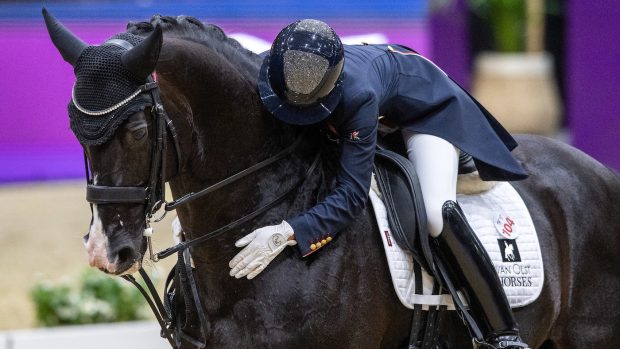The greatest dilemma facing most breeders is deciding to which stallion they should send their mare. For the German businessman Dr Wilfried Bechtolsheimer and his wife Ursula, that part was straightforward – they already owned their own proven stallion, the Olympic dressage horse Giorgione, who used to be competed by the current national champion, Carl Hester, before Wilfried took over the ride. Their problem was a lack of mares.
Now, however, their Eastington Stud, near Cirencester, boasts five quality mares.Ursula explains: “Originally, we had no plans to breed at all. In Germany, I was brought up to accept the precept of ¨leave the breeding to the breeders¨.
“But the German Oldenburger Verband suggested Giorgione should be graded, not just because of his competition success, but for his bloodlines.”
Giorgione is by the Hanoverian grand prix stallion Grundstein ¨ a son of the influential sire Graphit. Grundstein, also sire of the German team gold medal-winning horse Gracioso, was exported to America early on in his stud career.
Ursula says: “We thought that if his bloodlines were so valuable, then the only way to keep them was through good mares.
“Unfortunately, in England it isn¨t easy to find sufficiently high qualitymares, so we took advice from the Oldenburger Verband.”
As a result, Starlight Surprise (Sion) and Deutsche Eiche were brought to England. Deutsche Eiche (Donnerhall ex Pik Bube) is full-sister to the Oldenburg stallion Duntroon, as well as Donne, ridden by Sven Rothenberger. They have since been joined by First Lady (Feiner Stern) and Utima (Landadel), both purchased at the Vechta sales, representing a considerable and serious investment.
Alongside these four is the British-bred mare Evedon Magna. A former advanced eventer, she is an exciting British broodmare prospect, but does not quite match up to German standards.
“In Germany, she wouldn¨t be acceptable as she doesn¨t have proper papers,” says Ursula.The finishing touches are just being applied to a highly specialised, purpose-built yard for the mares, deliberately separated from the stallion-orientated sport horse yard by the smart indoor school. Even the covered walkways are protected with special non-slip rubber tiles which, as Ursula points out, have the added benefit of “the stallions not even being able to hear the mares walk in or out”.
Giorgione’s first progeny are still youngsters, but already Eastington Stud has a growing collection of young stock setting itself towards the aim of “producing good sport horses with temperaments to work with you”.
“Rideability is important, but they must be athletes, too,” says Ursula.Although Wilfried has not yet thought seriously about marketing his new product, he is doubtful whether the young horses will sell in this country.
“In Britain, it is difficult to get a realistic price for a young horse. In Germany, not only do you stand a chance of hitting the jackpot, but you will always get your costs back. The average price for a young horse at the Vechta sales was £15,000.”
While any sensible breeder hopes to procure some return on a long-term investment, is it realistic to breed top-class sport horses, especially in England, when Germany can readily supply the desired product?”Everyone raised their eyebrows when Australians started making their own wine, but now look at them,” says Wilfried. “The Dutch have quickly proved they can breed their own horses. But breeding is not only economics – it is also emotional.”
Indeed, for the Bechtolsheimers, Giorgione is much more than just a stallion. “Gino” has been with them for more than 11 years and, for Wilfried, was the key to his new dressage career. Previously an event rider in Germany, he took up dressage when the family based itself at Eastington House more than 13 years ago. “Coincidentally, the translation of his sire Grundstein’s name is “cornerstone”,” he says. “He has certainly been the cornerstone for us and now our breeding project.”
Onespin-off of the venture into breeding is that there are now mares in the sport horse yard. “Before, we had always ruled mares out,” says Wilfried. “But now my best horse is a chesnut mare.”That mare is Winniza, a huge-moving chesnut by Woerman. Onlynine years old, she is being prepared for her competition debut at big tour level.
Winniza is not yet earmarked for breeding, even with embryo transfer (ET). “We really want to maximise her talent. Even with ET, there is a lot of fiddling about -a lot of scanning and monitoring. She is a young horse and doesn’t need any more pressure.”
However, Wild Rose, a six-year-old mare by Weltmeyer, also being trained for competition, is expecting to Gino courtesy of ET.
Wild Rose, or Rosie, wasthe 1996 Bundeschampion three-year-old riding horse and was subsequently bought through the Vechta sales – featuring, prophetically, on the opposite page to Gino in the catalogue. On her arrival in England, she was put in-foal to Gino and turned out. Then, after a thunderstorm resulted in her staking her shoulder on the fence, Rosie withstood the journey to Newmarket, survived an operation and, remarkably, retained her foal.
Even more remarkably, she came sound and still has the biggest walk youcan imagine.Wilfried, who now holds a British passport, is still very much a competitor, and employed former British Olympic team member Kirsty Mepham as rider. He admits he doesn¨t want to go on forever and hopes that his daughter Laura will be keen enough to take over.
Would the dream be to see Laura compete on a son of Giorgione? “Of course, that would be the ultimate dream but, realistically, either/or would be fantastic. Together might be asking too much.”


